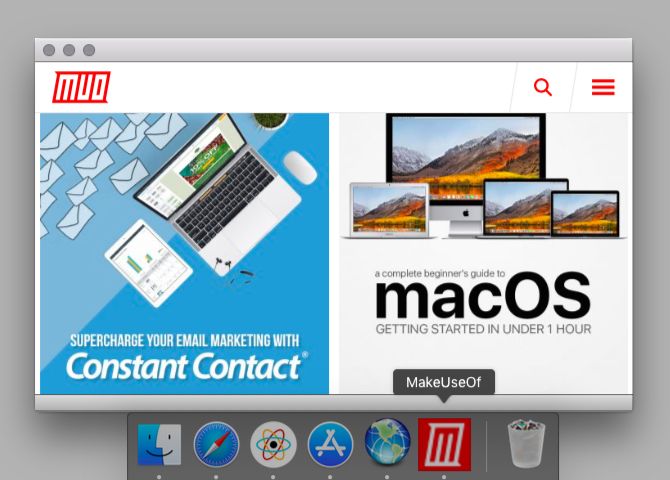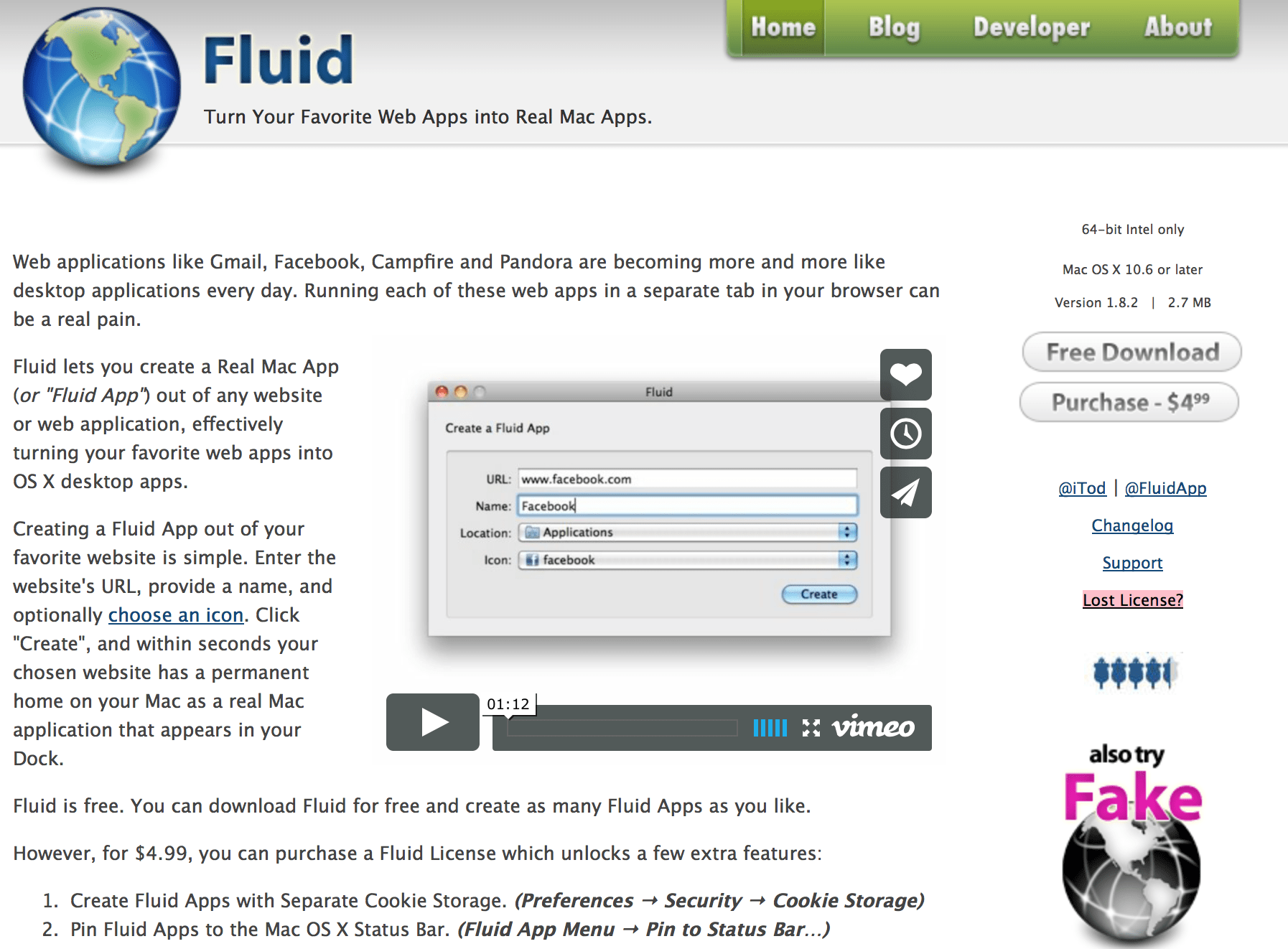Fluid Features:. Super high performance, adaptive remote desktop. Audio streaming. Strong encryption built into the protocol. Connect from anywhere, even restricted networks without requiring networking knowledge. Clipboard sharing VNC features:. Tested with Mac OS X, TightVNC, RealVNC, UltraVNC, Linux (Ubuntu Remote Desktop). By slide in and slide out, Slidepad brings iPad style multitasking to your Mac. Using Slidepad is as easy as using your dock. A simple sidebar to switch between apps. Slidepad borrowed the concept of sidebar from Franz and Station. It is much smoother than tabs, and it helps you quickly switch between different web apps.


| Click here to return to the 'Fluid - Create standalone apps from web pages' hint |
Fluid App Mac Os 10.13
Safari 4, not Snow Leopard. And Safari 4 definitely runs on my Leopard.
Sorry, sort of a combined summary of the rumors I've read: it's in Safari 4, but I'm not personally expecting Safari 4 to come out separately from Snow Leopard. I'll edit it for more clarity; thanks.
-rob.
Something worth noting is Fluid just uses webkit -- and webkit uses a central storage place for all of your Cookies, web databases (HTML5), and cache. The advantage of this is you don't have to re-enter login info/etc into each fluid app.
The disadvantage is you can't be logged into the same site as two different usernames (like Twitter -- I post to both a personal and a corporate account) even if you have them set up as separate independent apps.
Dunno if Safari 4 will allow you to have separate cookie jars, but I really hope they look into it... :)
So, it's not going to work with Google Apps, is it? Or with anything else that most people would consider worthwhile rolling into an application.
Kinda pointless, really. I generally use a second browser for this sort of thing. Sunrise is perfect for the job. It's a more flexible approach, and it's guaranteed to work with Ajax stuff.
Works everywhere Safari works. I have about a dozen Fluid apps.
Fluid App Mac Os 10.10
I've used the developer beta of Safari 4, and it does have this feature...
I had submitted a tip a while back about using Fluid.app to create a standalone Pandora app. I made mine into a menubar extra and it works great...
The English Wikipedia website displayed in a minimalist -configured site-specific browser window created by Fluid. | |
| Original author(s) | Todd Ditchendorf |
|---|---|
| Initial release | December 9, 2007[1] |
| Written in | Objective-C |
| Operating system | Mac OS X |
| Platform | WebKit, Cocoa |
| Type | Site-specific browser |
| License | Proprietaryfreeware with open-source components |
| Website | fluidapp.com |
Fluid is a WebKit2-based site-specific browser (SSB) for Mac OS X created by Todd Ditchendorf.[2][3] Its original WebKit-based version was compared to Mozilla Prism and mentioned in Lifehacker,[4] TechCrunch,[5][6][7] 43 Folders,[8] the 37 Signals blog,[9] and on InfoWorld[10] as a way to make web applications more like native desktop applications.
1.0 milestone[edit]
On May 1, 2011, Fluid 1.0 was released with a completely new codebase. Fluid Apps created with previous versions of Fluid cannot be updated via software update and SSBs have to be re-created with Fluid 1.0 (to transition to version 1.0 and later).[11] While version 1.0 is still a free app, a Fluid License can be purchased which will unlock extra features (some previously included by default in previous versions). On July 4, 2011, version 1.2 was released and featured compatibility with Mac OS X 10.7 Lion.[12]

2.0 milestone[edit]
Fluid App Mac Os Catalina
In July 2018, Fluid underwent another rewrite[13] to take advantage of Apple's newer WebKit2 API with process separation,[14] with the same licensing terms as 1.x versions. Subsequent minor versions restored feature support and added support for Dark Mode.
References[edit]
- ^'Fluid Blog » Blog Archive » Fluid Beta Released'. Fluidapp.com. 2007-12-09. Retrieved 2009-08-01.
- ^'Fluid - Free Site Specific Browser for Mac OS X Leopard'. Fluidapp.com. Retrieved 2019-07-19.
- ^'Turn any website into a real Mac app with Fluid'. Fluidapp.com. Retrieved 2019-07-19.
- ^Pash, Adam (2007-12-13). 'Add Webapps to Your Dock with Fluid - Downloads'. Lifehacker. Retrieved 2009-08-01.
- ^Riley, Duncan (2007-12-14). 'Fluid Is Great For People Who Are More Comfortable With Desktop Apps'. Techcrunch.com. Retrieved 2009-08-01.
- ^Arrington, Michael (2008-03-22). 'Bridging Desktop And Web Applications - A Look At Mozilla Prism'. Techcrunch.com. Retrieved 2009-08-01.
- ^Arrington, Michael (2008-04-07). 'Bridging Desktop And Web Applications, Part 2'. Techcrunch.com. Retrieved 2009-08-01.
- ^'Getting Sandy in my Face'. 43 Folders. 2008-01-20. Retrieved 2009-08-01.
- ^'Fluid: Wrap your favorite web apps in their own browser'. 37signals. Retrieved 2009-08-01.
- ^Wayner, Peter (19 October 2010). 'Top 10 specialty Web browsers you may have missed'. InfoWorld. p. 4. Retrieved 28 October 2010.
- ^'Fluid 1.0 Available Now'. Fluidapp.com. 2011-05-01. Retrieved 2011-07-09.
- ^'Fluid Changelog'. Fluidapp.com. 2011-07-04. Retrieved 2011-07-09.
- ^'Fluid, the app that converts websites into Mac apps, gets a major overhaul with support for WebKit2'. 9to5mac.com. 2018-07-03. Retrieved 2019-07-19.
- ^'Fluid Changelog'. Fluidapp.com. Retrieved 2019-07-19.